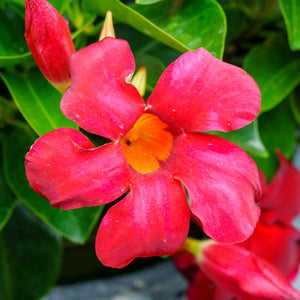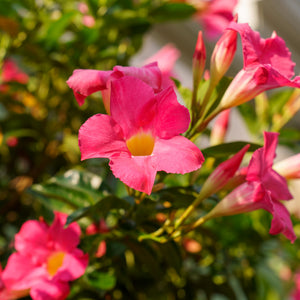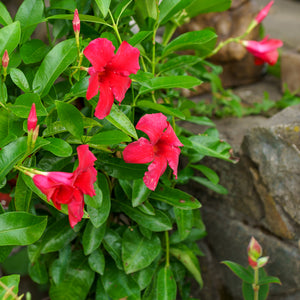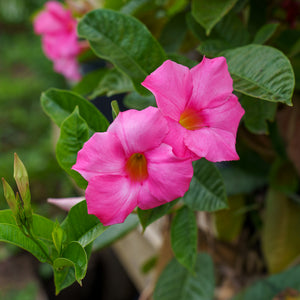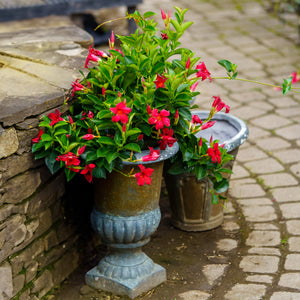The Mandevilla Guide
Mandevilla, with its bold trumpet-shaped flowers and vining habit, is a tropical showstopper prized for its long bloom season and ability to add height and color to vertical spaces. Often grown as an annual in cooler climates, mandevilla thrives in warm temperatures and full sun, making it a favorite for patios, trellises, and containers.
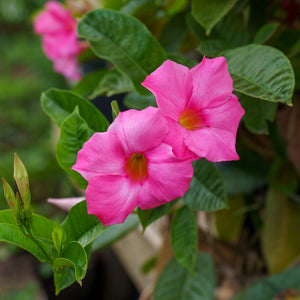
About
Native to South and Central America, mandevilla belongs to the Apocynaceae family. It produces vigorous vines with glossy green leaves and blooms in a spectrum of colors including pink, red, white, and peach. Mandevilla hybrids like Mandevilla x 'Sunmandeho' and 'Sunmandecos' are bred for extended blooming, compact growth, and adaptability to containers or trellises.
- 'Giant Peach Sunrise' delivers large, apricot-pink blooms on climbing vines.
- 'Sunbeam' brings a bright yellow flair uncommon in traditional mandevilla colors.
- 'Sunmandecrim' and 'Sunmandecos' are part of the Sun Parasol series, known for strong stems and heavy flowering.
These cultivars are typically grown as annuals in temperate regions but can be overwintered indoors with proper care.
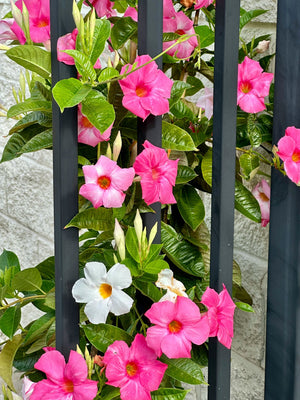
PLANTING
Mandevilla requires warmth, sun, and support to thrive and show off its full potential:
- USDA Hardiness Zones: Perennial in Zones 9–11; grown as an annual in colder zones.
- Soil: Well-draining potting soil enriched with compost or organic matter.
- Sunlight: Full sun (6+ hours per day) encourages dense growth and abundant flowering.
- Spacing: Space 18–24 inches apart for ground plantings. Use large containers with climbing support for container-grown vines.
- Planting Time: Plant after the last frost and when nighttime temperatures remain above 55°F.
If planting in the ground, choose a spot protected from strong winds and amend the soil with compost to improve drainage and fertility.
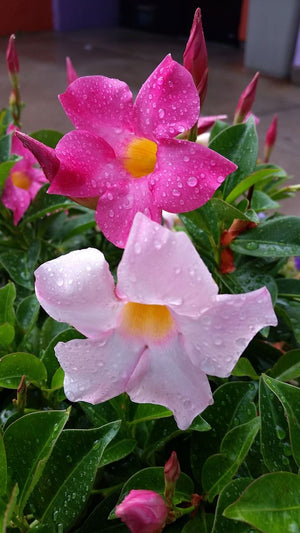
CARE
With the right conditions, mandevilla is an easy-care tropical vine that rewards gardeners with months of color:
- Watering: Water consistently during the growing season to keep soil lightly moist. Avoid waterlogged soil.
- Fertilizing: Use a balanced, water-soluble fertilizer every two weeks during spring and summer to encourage continuous blooms.
- Pruning: Trim back in early spring to shape the plant and remove leggy or damaged growth. Deadhead spent blooms to promote new flowers.
- Staking: Provide a sturdy trellis or obelisk early in the season. Guide new vines as they grow.
- Overwintering: In cold climates, bring mandevilla indoors before the first frost. Place in a sunny window or overwinter in a cool, bright room. Reduce watering and hold fertilizer until spring.
- Pests: Watch for aphids, spider mites, and whiteflies. Treat with insecticidal soap if necessary.
Mandevilla thrives with warmth, humidity, and consistent feeding—conditions that mimic its tropical origins.
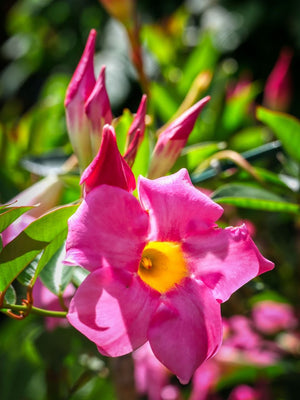
HOW TO USE
Mandevilla is a statement plant with flexible uses in outdoor and indoor containers or vertical spaces:
- Trellises & Arbors: Train mandevilla to climb structures where its vibrant flowers create a dramatic display.
- Containers & Hanging Baskets: Use compact cultivars like 'Sunmandecos' in patio pots or hanging baskets.
- Privacy Screens: Grow along balcony railings or porch columns to create lush green walls with seasonal blooms.
- Mixed Containers: Combine with trailing plants like sweet potato vine or calibrachoa for a lush tropical look.
- Indoor Accent: Overwinter in bright indoor spaces or grow year-round in sunny conservatories.
Pair mandevilla with hibiscus, coleus, or tropical grasses for bold, colorful plantings in sun-drenched spaces.
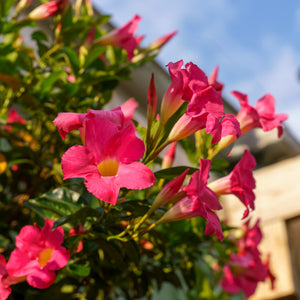
COMMON QUESTIONS
- Is mandevilla a perennial? Yes, in warm climates (Zones 9–11). It is grown as an annual or overwintered indoors in colder regions.
- How to care for a mandevilla? Provide full sun, well-drained soil, regular feeding, and climbing support. Prune and deadhead to encourage blooming.
- Can you plant mandevilla in the ground? Yes, in Zones 9 and above. In colder zones, treat as an annual or plant in containers for easy overwintering.
- Is mandevilla toxic to dogs? Yes, it can be mildly toxic if ingested, causing gastrointestinal irritation.
- Is mandevilla toxic to cats? Yes, mandevilla is also mildly toxic to cats and may cause vomiting or irritation.
- Do deer eat mandevilla? It is generally deer resistant due to its thick, milky-sapped foliage.
- Do rabbits eat mandevilla? Mandevilla is not a preferred food source for rabbits.
- How to grow a mandevilla trellis? Plant near a support structure and tie vines gently as they grow. Prune regularly for shape and fullness.
- How to winter a mandevilla? Move indoors before frost. Keep in bright, indirect light with reduced watering until spring.
- How to propagate a mandevilla? Take 4–6 inch cuttings in late spring or early summer. Root in moist potting mix or water in a warm, bright location.
Conclusion
Mandevilla is a striking vine that brings lush, tropical beauty to summer gardens and patios. With bold blooms, glossy foliage, and vigorous climbing ability, it makes an ideal choice for containers, vertical accents, and warm-climate landscapes. Whether you're growing 'Giant Peach Sunrise' up a trellis or showcasing 'Sunbeam' in a hanging basket, mandevilla delivers months of vibrant color and charm with relatively little fuss.
The Mandevilla Collection
Sold Out
Sold Out
Sold Out
Sold Out
Sold Out

